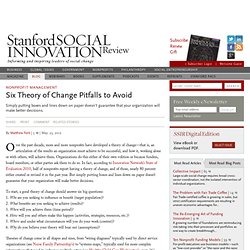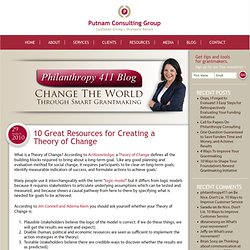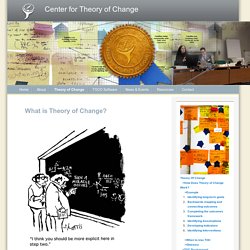

Six Theory of Change Pitfalls to Avoid. Simply putting boxes and lines down on paper doesn’t guarantee that your organization will make better decisions.

Over the past decade, more and more nonprofits have developed a theory of change—that is, an articulation of the results an organization must achieve to be successful, and how it, working alone or with others, will achieve them. Organizations do this either of their own volition or because funders, board members, or other parties ask them to do so. In fact, according to Innovation Network’s State of Evaluation 2010, half of nonprofits report having a theory of change, and of those, nearly 80 percent either created or revised it in the past year. But simply putting boxes and lines down on paper doesn’t guarantee that your organization will make better decisions.
To start, a good theory of change should answer six big questions: 1. 1. 2. 3. 4. 5. 6. Do these pitfalls resonate with your experience? Theory of Change: A Practical ToolFor Action, Results and Learning. An Introduction to Theory of Change / Evaluation Methodology / Issue Archive / The Evaluation Exchange / Evaluation. Andrea Anderson is a research associate at the Aspen Institute Roundtable on Community Change, where she focuses on work related to planning and evaluating community initiatives. What Is a Theory of Change?
A theory of change (TOC) is the product of a series of critical-thinking exercises that provides a comprehensive picture of the early- and intermediate-term changes in a given community that are needed to reach a long-term goal articulated by the community (see box for more detail). What Is the Value of Creating a TOC? Community initiatives are sometimes planned without an explicit understanding of the early and intermediate steps required for long-term changes to occur; therefore, many assumptions about the change process need to be examined for program planning or evaluation planning to be most effective. A TOC creates an honest picture of the steps required to reach a goal. How Can Initiatives Create a TOC? What Is the Process of Creating a TOC? Erin Harris, Research Analyst, HFRP. Theory of Change. "What are we doing, and why do we think it's going to make a difference?
Are we being effective? " Grantmakers ask evaluation questions like these of their grantees and themselves. This brief guide explains why grantmakers use theories of change to guide their questioning, unearth assumptions that underlie their work, establish common language, and develop strong action plans. Contributors to the guide also describe how a theory of change sets the stage for evaluation by clarifying goals, strategies, and milestones. What a theory of change looks like Theory of change vs. logic model Mini-case study: theory of change and strategic planning As grantmakers, we want evaluation and assessment techniques that help document and analyze the work we support in ways that are meaningful to our foundations, grantees, and wider field or community. "When you're clear about your theory, it's easier to see ... what other inputs might be needed and whether your input might fit in a catalytic place.
" 10 Great Resources for Creating a Theory of Change. What is a Theory of Change?

According to ActKnowledge, a Theory of Change defines all the building blocks required to bring about a long-term goal. ‘Like any good planning and evaluation method for social change, it requires participants to be clear on long-term goals, identify measurable indicators of success, and formulate actions to achieve goals.’ Many people use it interchangeably with the term “logic model” but it differs from logic models because it requires stakeholders to articulate underlying assumptions which can be tested and measured, and because shows a causal pathway from here to there by specifying what is needed for goals to be achieved. Theory of Change Community. Image credit: Sidney Harris Theory of Change is essentially a comprehensive description and illustration of how and why a desired change is expected to happen in a particular context.

It is focused in particular on mapping out or “filling in” what has been described as the “missing middle” between what a program or change initiative does (its activities or interventions) and how these lead to desired goals being achieved. It does this by first identifying the desired long-term goals and then works back from these to identify all the conditions (outcomes) that must be in place (and how these related to one another causally) for the goals to occur. These are all mapped out in an Outcomes Framework. The Outcomes Framework then provides the basis for identifying what type of activity or intervention will lead to the outcomes identified as preconditions for achieving the long-term goal.